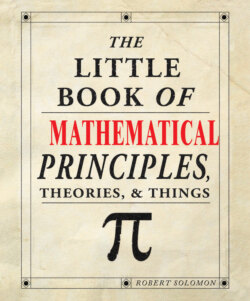Читать книгу The Little Book of Mathematical Principles, Theories & Things - Robert Solomon - Страница 31
3rd century BC Greece Quadrature of the Parabola Archimedes (287–212 BC)
ОглавлениеThis is about finding the area between a chord and a curve.
_______________
To evaluate the area between a chord and a curve, Archimedes found a way to add infinitely many numbers.
A parabola is an example of a conic which occurs in many places in science as well as mathematics. The reflecting surface of a space-telescope, such as that at Jodrell Bank in Manchester, England, is formed from a parabola.
The diagram (page 43) shows part of a parabola curve and a straight line crossing it. Archimedes found the area of the shaded region, between the line and the curve.
This area is 4/3 of the area of the triangle with the same base and height. Although this was not a terribly interesting result, it was the method of proof that was ground breaking. Put one triangle in the shaded region, which leaves two gaps. Put two triangles in the gaps, leaving four gaps. Repeat indefinitely; the area of all these triangles approaches the area required. The first two stages are shown.
The method of proof is known as the method of exhaustion. The infinite succession of triangles “exhausts” the area between the curve and the line.
Greek mathematicians distrusted any infinite process. Zeno’s paradoxes are about the adding of infinitely many terms and obtaining something finite. Archimedes showed that it was possible.
To find the area, Archimedes had to sum infinitely many smaller areas. He showed that this sum of infinitely many fractions:
1/1 + 1/4 + 1/16 +1/64 + 1/256 + ... has a finite value, 4/3.
This is the first recorded example of the summation of an infinite series, a key part of mathematics, and moreover it was found rigorously. The formal rigor of Greek mathematics was not achieved again until the 19th century.
Area between line and curve
“Exhausting” the area
It was rumored that Archimedes had a secret method to find these results. In 1906 a palimpsest (a document hidden under another, when the parchment was recycled) was found in a monastery in Constantinople (modern-day Istanbul). It contained The Method, a lost work by Archimedes, which showed how he had first obtained his results via informal reasoning. Essentially, it was the same as the integral calculus of Newton and Leibnitz. In 1998, Christie’s auction house in New York sold the manuscript for 2 million dollars to an unidentified collector in the United States.
See: Zeno’s Paradoxes, pages 30–31; Conic Sections, pages 33–34; Integration, pages 86–87
